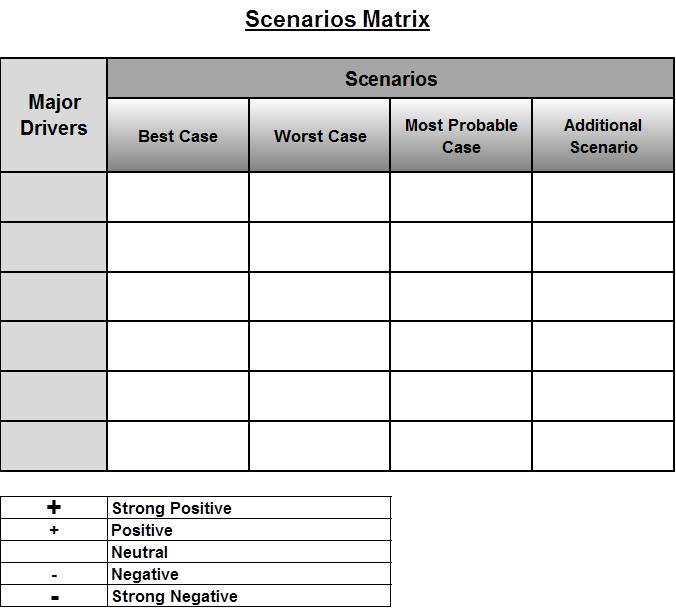
Scenarios Matrix
Analyze your drivers and scenarios.
Scenarios Matrix tool was designed to examine a full-range of possible futures. It’s a simple matrix with major drivers listed down the left-hand column and different scenarios going across the top.
To create a Scenarios Matrix:
Step 1: List your major drivers down the left-hand column (see diagram below). These are the Forces, Factors, and events (see Chronology) that will influence future outcomes. Keep it simple – start with 5 to 10 drivers.
Step 2: In the columns of your matrix, list your scenarios. Across the top of the matrix write your: 'best case' scenario, 'worst case', 'most probable case', and any other possible scenarios. Also add a brief description to each of your scenario to your column headings.
Step 3: Assign a different value to each driver/scenario pairing. You can use a simple plus/minus system: use a bold plus (+) for a 'strong positive' influence, plus (+) for 'positive', blank for 'neutral', minus (-) for 'negative', and bold minus (-) for 'strong negative'.
Analysis of your Scenario Matrix:
- Which drivers will influence how the situation develops?
- Challenge your key assumptions for your most likely outcomes.
- Determine what is 'observable' along the developmental paths leading to each outcome.
- Are there Indicators or 'turning points' that can be monitored for signs that a scenario may becoming more or less likely?
- Do any of your scenarios have high impact but low probability? Are you prepared for these 'wild card' outcomes?
The Scenario Matrix gives you a chance to rehearse a broad range of outcomes. Being prepared for all possible outcomes can provide you with an awareness and agility that you can use to exploit opportunities and mitigate risks.
Diagram of a Scenarios Matrix:

Word version of Scenarios Matrix.docx (Click link to download Word version).
Excel version of Scenarios Matrix.xlsx (Click link to download Excel version).
PDF version of Scenarios Matrix.pdf (Click link to download PDF version).

Sources:
Structured Analytic Techniques for Intelligence Analysis, Richards Heuer, Jr. and Randolph H. Pherson, Washington DC: CQ Press, 2011.
